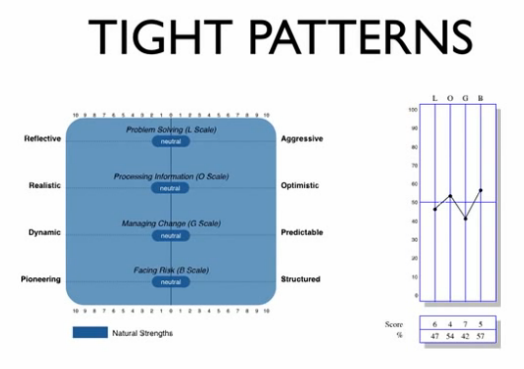What Do They Mean?
Your Leading From Your Strengths profile report (or your Marriage Insights profile report) includes two personalized charts: your Natural Strengths Chart and your Strengths Movement Chart. These charts are a visual representation of the data compiled from your questionnaire. The charts reveal your strengths in four areas: problem solving, processing information, managing change, facing risk.
Your plotted scores create a visual pattern in a graph. Each person’s graph is different because each person’s strengths are different.
 However, one type of graphed result is somewhat unusual and needs special consideration: a graph with a tight pattern or a neutral pattern. What do those kinds of profile results mean and how should you proceed if yours is like that?
However, one type of graphed result is somewhat unusual and needs special consideration: a graph with a tight pattern or a neutral pattern. What do those kinds of profile results mean and how should you proceed if yours is like that?
The following questions are asked most often about tight patterns and neutral graphs.
FAQ #1: What is a tight pattern on the profile graphs?
A tight pattern on the profile graph is one in which all scores in the four areas of differences are either neutral (0) or within one or two points on either side of the Energy Line (1 or 2). A tight pattern can occur on either the Natural Strengths Chart or the Strengths Movement Chart.
FAQ #2: What is a neutral graph?
In the strictest sense, a neutral graph is one in which the scores in each of the four areas are labeled “neutral.” However, for general purposes the term “neutral graph” is considered to be nearly synonymous with “tight pattern.”
FAQ #3: What does a tight pattern or a neutral graph indicate?
These two unusual patterns indicate stress or discomfort.
If the pattern occurs on the Natural Strengths Chart, then the stress or discomfort is internally-driven, meaning the user is struggling with an identity issue or personal conflict. The tight or neutral scores reveal that the user may have attempted to outsmart the questionnaire, over-analyzed the questions, is experiencing a significant emotional event or personal trauma, or is under pressure to be someone he is not.
If the pattern occurs on the Strengths Movement Chart, then the stress or discomfort is environmentally-driven. The user’s current environment or expectations within that situation are creating conflict. Like the individual with tight graph responses in a Natural Strengths Chart, this person may have attempted to outsmart the questionnaire or over-analyzed the questions. But this person may face two other challenges. He may be trying to be an overachiever. Or he may be new to his job or environment and may not yet understand the behavior that is required in order for him to be successful.
FAQ #4: What steps should I take if the Natural Strengths Chart reveals a tight pattern or neutral graph?
By processing the information on the graphs, the user can discover the factors that are influencing the tight pattern or neutral graph . Look for the factors by asking these questions:
1. Are you experiencing a significant emotional event or a personal trauma? Most tight patterns are driven by upheaval in some form.
2. Do you feel you were over-analyzing the questions in the profile assessment by taking too long to respond?
3. Do you feel under pressure to “be all things to all people”?
While these three factors are the most predominant causes for tight patterns and neutral graphs, in a few cases you may not get anywhere. If so, then ask this additional question: Were you trying to outsmart the questionnaire?
If the individual answers yes to any of these four questions, move on to Exercise 1 to help them uncover truths about his or her strengths. If the individual answers no to all of the questions, then move directly to Exercise 2.
FAQ #5: Describe Exercise 1.
Go to the General Characteristics section of the profile. Have the individual read the first statement and indicate if it is true. The individual will have one of four responses.
- “Yes, it is true.” If the individual says it is true, have them expound on it.
- “No, it is not true.” If the individual says it is false, have them explain why. Determine if the statement should be blotted out or if the person might have a blind spot.
- “Yes, but it needs to be edited.” If the individual says the statement needs to be edited, ask them to do so. Encourage them to share further what part of the statement is true and what about it needs to be changed.
- “It is questionable” or “I’m not sure.” In this instance, the individual is not certain whether or not the statement is true. Probe more deeply. Invite someone else into the discussion to help clarify the truth of the statement – perhaps a professional or someone that knows the individual well.
Use this process with the first 17 pages of profile – each statement in the General Characteristics section, along with statements in the Do’s and Don’ts for Communicating and other sections.
After completing the process, have the person retake the questionnaire, using guidelines for Exercise 2.
FAQ #6: Describe Exercise 2.
Exercise 2 allows the person to re-take the profile, but with the encouragement to keep the following in mind:
- Remember that there is no pass or fail.
- Know that there are no right or wrong answers.
- Do not try to give answers that seem favorable or politically correct, but rather answer as honestly as possible. The assessment looks only at strengths.
- Push through the questionnaire to do your best to complete it in 10 minutes or less.
Self-Discovery Is Powerful
The goal is to help the individual to discover more information about his or her strengths. The act of discovery is powerful. Take your time as you work through the process with your profile or as you serve another as a certified practitioner. A tight pattern or neutral graph offers the user the opportunity to dig deeper and discover more about his strengths.
While tight patterns or neutral graphs may require more effort to decipher than other results, the outcome can be exciting and life-changing. By undergoing this process, you are helping put off those concepts that may be confusing or creating struggle as you “Test all things (and) hold fast to what is good” (1 Thessalonians 5:21, NKJV).
Help Video
Help Video: How to Read Tight Patterns and Neutral Graphs
More FAQs: Frequently Asked Questions
FAQs: How to Customize Your Communication with People Who Have Other Strengths
FAQs: Report Consolidation Template – Your Profile on One Page
FAQs: The Energy Line on the Strengths Charts
